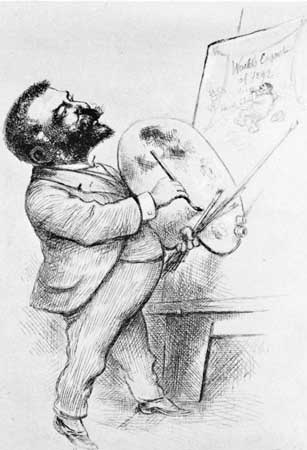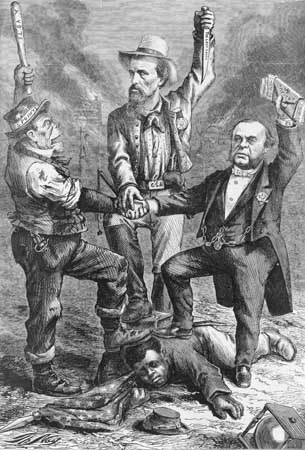Nast, Thomas
American political caricaturist
born Sept. 27, 1840, Landau, Baden 【Germany】
died Dec. 7, 1902, Guayaquil, Ecuador
 American cartoonist, best known for his attack on the political machine of William M. Tweed (Tweed, William Magear) in New York City in the 1870s.
American cartoonist, best known for his attack on the political machine of William M. Tweed (Tweed, William Magear) in New York City in the 1870s.Nast arrived in New York as a boy of six. He studied art at the National Academy of Design and at the age of 15 became a draftsman for Frank Leslie's Illustrated Newspaper and at 18 for Harper's Weekly. In 1860 he went to England for the New York Illustrated News and in the same year went to Italy to cover Giuseppe Garibaldi's revolt for The Illustrated London News and American publications.
 With the outbreak of the American Civil War, Nast vigorously supported the cause of the Union and opposed slavery from his drawing board at Harper's Weekly. His cartoons “After the Battle” (1862), attacking Northerners opposed to energetic prosecution of the war, and his “Emancipation” (1863), showing the evils of slavery and the benefits of its abolition, were so effective that President Abraham Lincoln called him “our best recruiting sergeant.” During Reconstruction, Nast's cartoons portrayed President Andrew Johnson as a repressive autocrat and characterized Southerners as vicious exploiters of helpless blacks, revealing his bitter disappointment in postwar politics.
With the outbreak of the American Civil War, Nast vigorously supported the cause of the Union and opposed slavery from his drawing board at Harper's Weekly. His cartoons “After the Battle” (1862), attacking Northerners opposed to energetic prosecution of the war, and his “Emancipation” (1863), showing the evils of slavery and the benefits of its abolition, were so effective that President Abraham Lincoln called him “our best recruiting sergeant.” During Reconstruction, Nast's cartoons portrayed President Andrew Johnson as a repressive autocrat and characterized Southerners as vicious exploiters of helpless blacks, revealing his bitter disappointment in postwar politics.Many of Nast's most effective cartoons, such as his “Tammany (Tammany Hall) Tiger Loose” and “Group of Vultures Waiting for the Storm to Blow Over” (both 1871), were virulent attacks on New York's Tammany Hall political machine led by “Boss” Tweed. His cartoons were probably one of the chief factors in the machine's downfall. Nast's caricature of the fleeing political boss led to Tweed's identification and arrest in Vigo, Spain, in 1876.
By 1885 Nast's disagreements with the editors of Harper's Weekly were becoming increasingly frequent; his last Harper's cartoon appeared in 1886. His contributions to other journals became infrequent and, having lost nearly all his savings in the failure of the brokerage house of Grant & Ward in 1884, he became destitute. He was appointed consul general at Guayaquil, Ecuador, in 1902.
Nast did some painting in oil and book illustrations, but his fame rests on his caricatures and political cartoons. From his pen came the Republican Party's elephant, Tammany Hall's tiger, and one of the most popular images of Santa Claus. He also popularized the Democratic Party's donkey.
- Sir Huw Pyrs Wheldon
- Sir Ian Hamilton
- Sir Ian McKellen
- Siribunyasan
- Sirica, John
- Siricius, Saint
- Sirimavo R.D. Bandaranaike
- Sirionó
- Sir Isaac Brock
- Sir Isaac Lyon, 1st Baronet Goldsmid
- Sir Isaac Lyon Goldsmid, 1st Baronet
- Sir Isaac Newton
- Sir Isaac Pitman
- Sir Isaac Shoenberg
- Sir Isaiah Berlin
- Sirius
- Sir Jack Brabham
- Sir Jacob Epstein
- Sir Jadunath Sarkar
- Sir Jagadis Chandra Bose
- Sir James, 1st Baronet Kay-Shuttleworth
- Sir James, 1st Baronet Outram
- Sir James, 1st Baronet Paget
- Sir James, 2nd Baronet Graham
- Sir James, 4th Baronet Hall